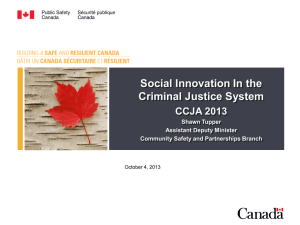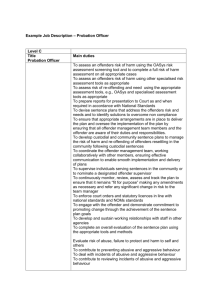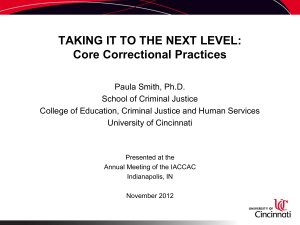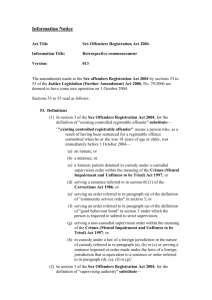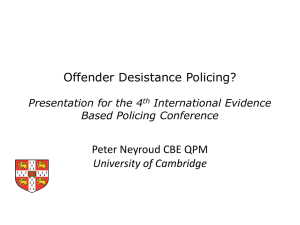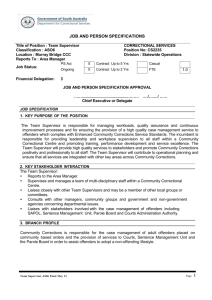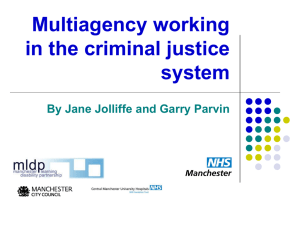CHAPTER 6
advertisement
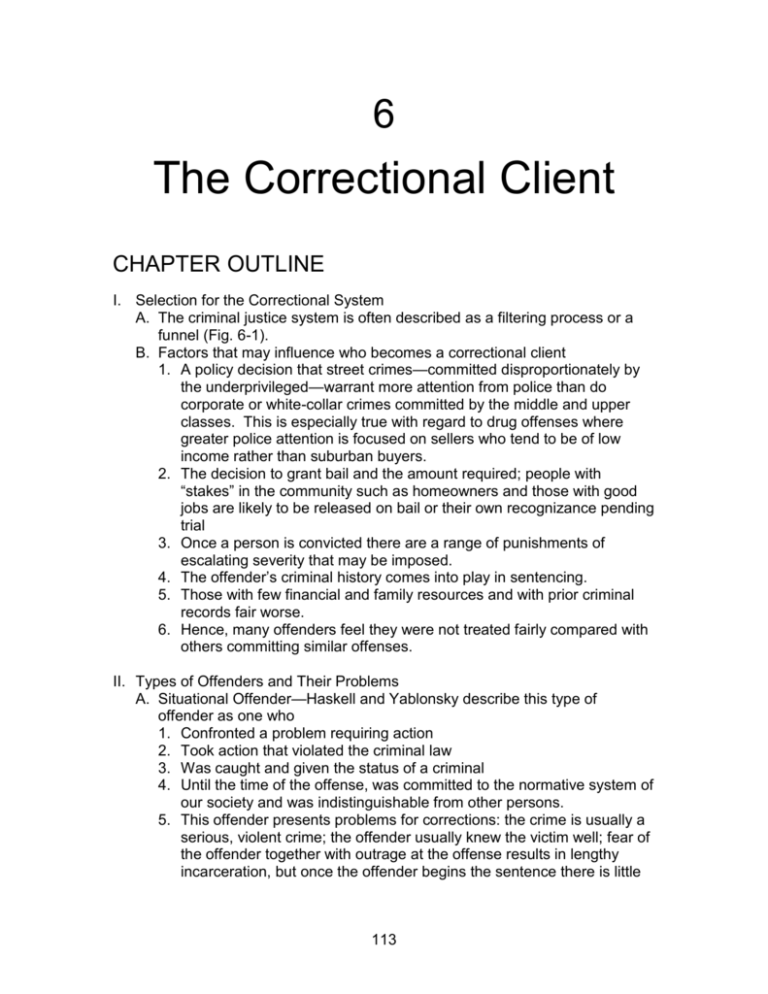
6 The Correctional Client CHAPTER OUTLINE I. Selection for the Correctional System A. The criminal justice system is often described as a filtering process or a funnel (Fig. 6-1). B. Factors that may influence who becomes a correctional client 1. A policy decision that street crimes—committed disproportionately by the underprivileged—warrant more attention from police than do corporate or white-collar crimes committed by the middle and upper classes. This is especially true with regard to drug offenses where greater police attention is focused on sellers who tend to be of low income rather than suburban buyers. 2. The decision to grant bail and the amount required; people with “stakes” in the community such as homeowners and those with good jobs are likely to be released on bail or their own recognizance pending trial 3. Once a person is convicted there are a range of punishments of escalating severity that may be imposed. 4. The offender’s criminal history comes into play in sentencing. 5. Those with few financial and family resources and with prior criminal records fair worse. 6. Hence, many offenders feel they were not treated fairly compared with others committing similar offenses. II. Types of Offenders and Their Problems A. Situational Offender—Haskell and Yablonsky describe this type of offender as one who 1. Confronted a problem requiring action 2. Took action that violated the criminal law 3. Was caught and given the status of a criminal 4. Until the time of the offense, was committed to the normative system of our society and was indistinguishable from other persons. 5. This offender presents problems for corrections: the crime is usually a serious, violent crime; the offender usually knew the victim well; fear of the offender together with outrage at the offense results in lengthy incarceration, but once the offender begins the sentence there is little 113 for corrections to do; with prison overcrowding, they are most appropriate for release since they pose little threat to the public. 6. These offenders pose a great problem for the system, for they are well adjusted and there is little that can be done. There are few positive steps that can be taken. B. The Career Criminal 1. There are several specific attributes. a. Crime is his way of earning a living. b. He develops technical skills useful for offending. c. He started as a child. d. He expects to do time as a cost of business. e. He is psychologically normal. 2. Research in the 1980’s led scholars to believe that a small group of offenders commit most crime. 3. This led to a change in thinking that those with as few as three offenses could be labeled a career offender. 4. Still, in the Peter Greenwood study, most repeat offenders were not high rate offenders. 5. Political pressures led to a need to classify all repeat offenders as career criminals. 6. This caused a great many non-professional but intermittent offenders being misclassified. C. The Sex Offender 1. The Rapist: Rape is primarily an act of violence against women, not sexually motivated but for a desire for violent coercion; presents difficulties for correctional management; may be a security risk inside prison. 2. The Child Molester: few offenses are so uniformly reviled; as many as 90% of child molesters are estimated to have been molested as children; as many as 20% are over 50; they are certain to be the target of threats, violence and hostility from other prisoners. 3. The Prostitute: prostitution is an illegal economic transaction between a service provider and a customer. One third got started through family or friends, and many started at 15. 4. Sixteen states have enacted Violent Predator statutes, arguing that sex offenders, particularly rapists and child molesters, are likely to repeat offend. a. However, studies show that of 10,000 sex offenders, only 5.3% were rearrested for a sex crime. b. Moreover, while 43% have a new arrest overall (for something) that compares to 68% of all other offenders. 5. Rape was redefined as a violent coercive crime in the 1970s. Hence, it became a gender neutral “sexual assault” and this resulted in more harsh sentences than previously. 114 D. The Substance Abuser: 4 out of 5 jail and prison inmates “had been high when they committed their crimes, had stolen to support their habit or had a history of drug and alcohol abuse that led them to commit crime." 1. The drug abuser: ours is a drug-using culture; 30% of those serving time for violent offenses admitted they were under the influence of an illegal drug when they committed the crime; nearly 1 in 4 inmates are there for drug crimes; problems for corrections include drug dependency, control problems, crimes to generate income and compulsive behavior. Crime is often committed to support a habit. 2. The alcohol abuser: alcohol is widely available and relatively inexpensive and consumption is an integral part of life in the US; problems for corrections include an ambivalent public attitude and treatment issues. E. The Mentally Ill Offender 1. Only 3% of violent offenders suffer from schizophrenia, manic depression, or major depression. a. However, there are 300,000 inmates with one of those mental disorders. b. An additional 500,000 on probation have spent at least one night in a mental hospital at some point in their lives. c. Less able than other offenders to think realistically about their conduct. 2. There is overlap between “career criminals” and “psychopathic” offenders. a. Both engage in frequent criminal activity. b. The distinction is that a psychopath is “an asocial, aggressive, highly impulsive person, who feels little or no guilt and is unable to form lasting bonds of affection with other human beings.” c. Whereas the psychopath has no attachments to rules or people, the career criminal is motivated by economic gain. 3. Research has demonstrated, however, that the mentally ill a. Are not over-represented in the population of violent criminals. b. People identified as mentally ill generally pose no greater risk of violence than does the population as a whole. 4. The general population links mental illness, crime, and the insanity defense, but a. Only 8 % of convicted or accused people in mental hospitals are there for “not guilty by reason of insanity defenses. b. 6 % have been judged disordered sex offenders. c. 32 % have been found incompetent to stand trial. d. and 54 % consists of offenders who became mentally ill after conviction and incarceration. This is the largest problem for corrections. 5. Much of the increase in the mentally ill in prison was a result of deinstitutionalization. 6. Nearly 20% of violent offenders are mentally ill. 115 F. The Mentally Handicapped Offender 1. About 2% of the US population are mentally handicapped or developmentally disabled (IQ below 70). a. About 5% of the incarcerated population is in this category. b. No known link between this disability and criminal behavior c. Get duped into offenses due to their lack of mental ability d. Get caught more often because they cannot think quickly enough to avoid capture e. Normal course of correctional treatments do not work for these offenders. 2. Because they have difficulty adjusting to the rules of the community, they often come to the attention of the criminal justice system. G. The Offender with AIDS 1. In 2001 more than 5,700 prisoners had AIDS. a. More than 22,000 were HIV positive. b. This represents 1.9% of all prisoners. c. This is down from 2.3 % six years earlier. d. More than 250 inmates died of AIDS in 2001, down by 75% from six years earlier. 2. Prevention: knowledge is a key way to prevent transmission; policies have been developed for both correctional personnel and inmates; the problem is where to house them—general population or segregated; both physical and psychological medical care are needed, but those services are costly. 3. Most prison systems segregate those who have AIDS but leave asymptotic HIV carriers in the general population. 4. High risk behaviors however will also lead to segregation. 5. The cost of medical care for this population is alarmingly high – as much as 50,000 to 300,000 dollars per patient/prisoner per year. H. The Elderly Offender: 1. America’s prison population is aging due to the population getting older and harsher sentences being imposed. a. In 2003 there more than 66,000 offenders incarcerated who were over 55. b. That is a 75% increase over 1996 figures. c. There are generally three types of elderly prisoners. d. Young offenders initially sentenced to very long terms of incarceration. e. Those who enter prison in their old age. f. Those career criminals who come back again. 2. Aging prisoners have trouble handling the physical strains of prison life and they need a. Special employment needs b. Special housing needs c. Special family tie maintenance needs d. Special medical care needs 116 e. Special needs for release on parole or probation f. An inmate over 60 years of age costs more than three times the cost of a younger inmate. 3. George Wills Project for Older Offenders I. The Long-Term Offender 1. More prisoners serve long sentences in the U.S. than in any other Western nation. a. Most convicted of violent or drug offenses b. Not generally seen as a control problem 2. Program managers must make life livable for them, which is difficult. III. Classifying Offenders: Key Issues A. Overlap and Ambiguity in Offender Classifications 1. In order to combat ambiguities in classification, correctional administrators have started using classification systems, which apply a specific set of objective criteria to all inmates in order to arrive at appropriate classification. a. Offense histories b. Previous experiences in the system c. Substance abuse patterns 2. By using objective criteria, these systems reduce the unreliability of the offender’s classification; by limiting to a few relevant facts, overlap is avoided. B. Offense Classification and Correctional Programming 1. Some critics have argued that the most important requirement for any correctional classification system is that it should improve our ability to manage and treat offenders effectively. 2. Narrower and more precise classification systems are required for the programmatic needs of corrections. 3. Corrections must be able to identify the offender’s risk to correctional security and to the community. C. Behavioral Probabilities in Classification 1. A probabilistic approach to classification, making educated guesses about a person’s likely future behavior, will more often than not be right. 2. Like automobile insurance companies and actuarial risk factors, offenders with higher risk characteristics can be classified as more likely to pose a threat and therefore pay a penological “premium”: higher bail, closer supervision, tighter security, etc. D. Sociopolitical Pressures and Classification: 1. Public response to crime frequently makes classification an emotionally charged issue. 2. Corrections is forced to respond to changing public demands in managing offenders. E. Distinctions in the Criteria for Classifying Offenders 117 1. Offender classification must be seen as a rough way of grouping people. 2. 3 criteria are used to classify offenders: seriousness of the crime committed; probability of future criminal conduct; the nature of correctional treatment appropriate to the person’s need and situation. 118


